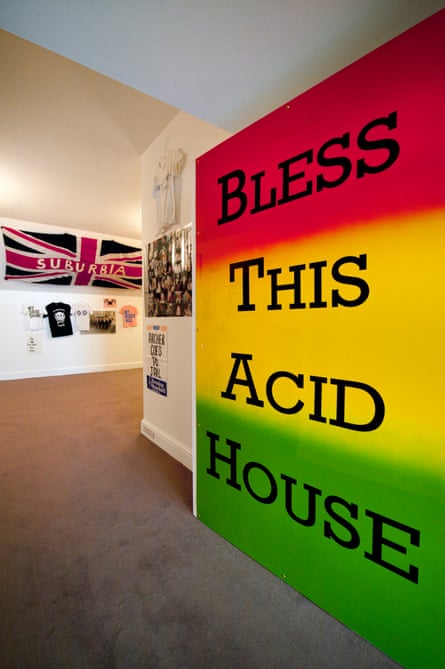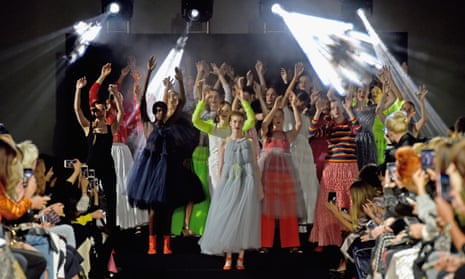Before the May bank holiday in 1992, Castlemorton Common in the Malvern Hills was chiefly known only to walkers keen to hike through its 600 acres of unspoilt, unenclosed land. After that bank holiday, however, it became known as the site of Britain’s biggest-ever illegal rave.
Partygoers arrived in such numbers that Castlemorton featured on TV and in the newspapers – which brought more revellers. In the end, an estimated 20,000 people flocked to the site. By the Tuesday, it had induced moral panic in the Daily Mail: “A walk through the hippy encampment was like walking into a scene from the Mad Max movies. Zombie-like youngsters on drugs walked aimlessly through the mobile shanty town or danced to the pounding beat,” it reported. By 1994, the Criminal Justice and Public Order Act was passed, with the now infamous ruling against parties playing music “characterised by the emission of a succession of repetitive beats”.
Twenty-five years after Castlemorton, rave is back in the pop culture mix. The aesthetic, culture and sound has trickled down to everything from the growth of the festival to the concept of chill-out, to your DayGlo wallet, clubbing scenes in Girls, a weekend in Ibiza and the Kirakira app’s sparkles. Most people might not be regularly indulging in four-day parties but, in 2017, rave’s cultural legacy extends far and wide.

“Artists see it as a halcyon age,” says Seb Wheeler, head of digital at dance and clubbing magazine Mixmag. “I’m 29 and acid house started in the late 80s, so that’s my whole lifetime of dance music to explore … There are dance music legends that you will hear from your older brother or your parents and you’re like: ‘I’m going to check that out,’ and head down a wormhole on YouTube or a specialised playlist on Spotify.” Wheeler points to Bicep, the dance music duo, as the act most influenced by the rave sound, which itself developed from acid house roots in Chicago. Since 2008, the duo’s Feel My Bicep blog has brought their favourite tracks from the genre to other fans. These fans will soon also be able to watch the story unfold: Irvine Welsh, the author of Trainspotting, is working on a TV series, Ibiza87, about the roots of the movement. Matthew Collin’s upcoming Rave On, meanwhile, is a follow-up to his acid house book Altered State, telling the story of how rave went from underground to ubiquity.
Fashion brands including Charles Jeffrey, Molly Goddard, Christopher Shannon and Comme des Garçons – more known for conceptual experimentation than clothes for the dance floor – have all brought rave to the catwalk. The latter’s menswear show was a highlight of the SS18 season, with young men dancing, coloured lights and clothes made of neon glittery fabric last seen on Camden Lock market stalls in the 90s. Meanwhile, Russian designer Gosha Rubchinskiy, currently fashion’s golden boy, staged his spring collection in St Petersburg’s first-ever rave venue. He also published a zine with 90s images of teenagers on the rave scene in Russia, at clubs such as Tunnel.

For these designers, rave is inspiring as an authentic youth culture. Goddard says she was influenced to turn her SS17 show into a rave from watching videos of raves at Lewisham library and thinking about her own youth going out to “parties in Hackney Wick and posh clubs in Mayfair”. Shannon’s sportswear aesthetic is influenced by the Joe Bloggs and Naf Naf clothes he saw his older brothers wear going out dancing. “I can remember wearing an acid house T-shirt on a school trip and getting told off,” he says. “Even if I didn’t understand it, [rave] taught me about clothes’ ability to antagonise things.”
Artists are also exploring rave. Jeremy Deller uses rave’s smiley face repeatedly in his work, and his Bless This Acid House posters are almost as popular as the Strong and Stable My Arse versions in households prone to making arty liberal statements. As part of Frieze art fair in October, Jarvis Cocker staged his Dancefloor Meditations, a kind of lecture-meets-disco with lasers, 808s and total darkness.
Nav Haq, the curator of the Museum of Contemporary Art Antwerp, staged an exhibition on the impact of rave, Energy Flash, last year. He says the period is relevant now because it shows what we are lacking: rave is typically seen as the last genuine subculture. “It’s hard to see something emerging in the same way now. People talk about the digital realm but that’s difficult because it gets corporatised very quickly. Youth movements emerge through things that happen in the world – the riots in 1968, the recession in the late 80s and early 90s. We’re in a similar period of time, but we have not been able to create that movement somehow.”

As with any subculture, rave has become mythologised. It is remembered as a scene where community was key and money was insignificant, but that was not the case for long. The popularity of ecstasy had repercussions beyond breaking down barriers on the dancefloor – it brought with it organised crime. By the 90s, drug dealers with baseball bats were found at rave mecca The Haçienda and rising security bills contributed to the club’s closure. Rave going mainstream spawned opportunists ready to cash in, too. Wheeler points to Tony Colston-Hayter, the Sunrise rave promoter – and later fraudster. “This is a weekend youth culture,” he told an interviewer at the time. “A city banker can shed his suit, put on his dungarees, dance all Saturday night away.” Parties such as his – that do not fit the narrative of rave as cultural disrupter – have their own legacy in clubs as business: see the phenomenon of Elrow, a party organiser from Barcelona that will host 132 events globally this year, reaching an audience of 1.7 million people. In a recent article, Resident Advisor called it “the world’s most popular clubbing brand”.
The Facebook page Humans of the Sesh was started in 2015 by two friends calling themselves Brown Sauce and Grand Feen. It is dedicated to detailing the bantz around the house party, the after party and impromptu bender, all under the umbrella of the “sesh”. Brown Sauce, though, is convinced his fun will never live up to what he sees calcified in grainy images of ravers. “There is a massive feeling that everyone went to a great party but we were too late,” he says. “Our idea of a good party – the huge speakers, the warehouse space – is based on the idea of a rave, even if you don’t know what a rave is. There’s a nostalgia to that era even if you weren’t around then.”
There are some trying to make their own versions on the free party scene, working against how corporate the mainstream nightlife scene has become by going back to the ideology of rave. Scum Tek, the collective that organised the “Scumoween” party in 2015 that ended in confrontation with the police, has members from the original scene, and an anti-establishment feel. A Vice documentary last year, Locked Off, told the story of various collectives that aim to put on illegal parties around the country in disused warehouses and squats, a cat-and-mouse game between organisers and the police. Footage shows teenagers dancing to a backdrop of lasers, jumpers tied around their naked torsos, dummies in the mouths – convincing facsimiles of the ones in the original rave pictures but for the balloons of Nitrous Oxide. “It’s not simply a bunch of guys with a bunch of speakers in a field,” says a partygoer at one point. “It’s bringing people together in a way that nothing else really does.”
The political backdrop of rave will feel familiar to the young people of today. It’s one of a less-than-stable Conservative prime minister (John Major then, now Theresa May) who reached power through a resignation; a crash in recent memory (1987 then, 2008 now); high levels of youth unemployment (800,000 18-to-24-year-olds in the early 90s, around 850,000 16-to-24-year-olds in 2016), and general unrest expressed through riots and demonstrations (the 1990 poll tax riots; the Brexit and Grenfell Tower protests). “People will always create music to escape when they’re skint and there’s a Tory government inflicting spending cuts,” says Wheeler. “It’s a form of rebellion.”

Will Stronge is trying to fuse the anger of disenfranchised young people with the desire to dance. The theorist found himself in the spotlight in September when the concept of Acid Corbynism – coined by Jeremy Gilbert and fleshed out by Matt Phull and Stronge – went viral. While the Acid Corbynism event at the Labour Party conference looked closer to Peep Show’s Rainbow Rhythms than a Spiral Tribe rave, the theory is interesting. Taking acid house as one of its bases – a scene where the collective ruled and everyone was welcome on the dancefloor – Stronge and Phull argue that encouraging similar values now could upset the establishment in a joyful way. “The ecstatic moments on the dancefloor tie into what it is to be a person, a person [who is] part of a community,” Stronge says. “Dance music as a collective experience means it’s already political, but it’s whether or not you can maintain that political experience as part of a larger cultural project.”
Stronge, 27, who is off to a six hour Erol Alkan DJ gig after I speak to him, is far from nostalgic. In an article for Red Pepper magazine, he namechecks contemporary musicians including Jam City and the Circadian Rhythms record label as signs that something is happening. Circadian Rhythms even apparently pepper their radio show with shout-outs to Diane Abbott. Stronge believes a genuine subculture could emerge from this scene – one that could outsmart the corporate world’s tendency to jump on anything young people flock to. “This is a call to say, ‘Let’s find ways that youth culture can become counterculture.’ How do we not make the mistakes so our revolutions aren’t sold back to us?” he says. “At its core, dance culture is where we can have individual pleasure through collectivity.” Or, in the words of Jarvis Cocker at Dancefloor Meditations, “Having fun is the most profound form of protest there is.”

Comments (…)
Sign in or create your Guardian account to join the discussion